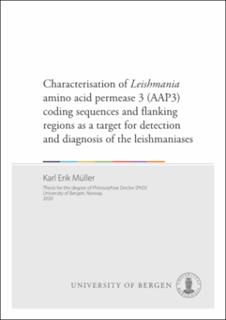| dc.contributor.author | Müller, Karl Erik | en_US |
| dc.date.accessioned | 2020-06-17T12:41:33Z | |
| dc.date.issued | 2020-05-29 | |
| dc.date.submitted | 2020-05-19T07:15:58.340Z | |
| dc.identifier | container/a0/ff/96/13/a0ff9613-ad35-41fe-884f-ec8d893f5339 | |
| dc.identifier.isbn | 9788230850541 | en_US |
| dc.identifier.isbn | 9788230869475 | en_US |
| dc.identifier.uri | https://hdl.handle.net/1956/22682 | |
| dc.description.abstract | The protozoan parasites of Leishmania genus are the etiological agents of the leishmaniases, diseases whose clinical manifestations range from being asymptomatic, self-healing cutaneous lesions, via mutilating muco-cutaneous lesions, to a potentially lethal visceral form. The World Health Organization defines the leishmaniases as neglected tropical diseases (NTDs). The aim of this thesis was to explore a new potential target, the amino acid permease 3 (aap3) coding regions and flanking nucleotide sequences for parasite detection and species identification. In four papers, the findings from research on the general and specific aims are presented. In paper I, theaap3 coding sequence was investigated for its potential as a target for parasite detection. Using real-time polymerase chain reaction (real-time PCR) the developed assay was useful for qualitative purposes, and when run in duplex with a host specific gene-assay, it was also able to quantify parasites in the mammal host. In paper II, the aap3coding sequence was investigated for its potential as a target for species discrimination. Using high resolution melting (HRM) analysis, aap3was found to be a specific and sensitive target for Leishmania species-identification. The method was validated on samples from humans, from experimentally infected mice, as well as from naturally infected sand flies. In paper III, a multi-centre prospective clinical study on the occurrence, diagnosis, treatment of the leishmaniases in Norway was performed. Biopsy material was collected to validate aap3as a target in clinical samples. In this material, the small subunit ribosomal RNA coding sequence (SSU rDNA), a molecular target routinely used in Leishmaniadetection tests, was found to be more sensitive in conventional PCR assays. Skin biopsy was the most appropriate material for diagnosis in cutaneous leishmaniasis. In paper IV,the aap3gene region from several Leishmaniaspecies was sequenced using single molecule real-time (SMRT) sequencing. In all species analysed, two copies of the encoding gene sequences organized in tandemwere found. These sequences are conserved within the species and between species of the same subgenera. In conclusion, this thesis shows that aap3with appropriate technology can be a sensitive and specific target for both genus detection and species discrimination. Furthermore, precise sequencing of aap3, as described here, can be a very useful tool in subsequent gene editing studies for a better understanding of the physiology and genetics of these parasites. | en_US |
| dc.language.iso | eng | eng |
| dc.publisher | The University of Bergen | eng |
| dc.relation.haspart | Paper I: Detection of a broad range of Leishmania species and determination of parasite load of infected mouse by real-time PCR targeting the arginine permease gene AAP3. Tellevik MG, Müller KE, Løkken KR, Nerland AH. Acta Tropica 2014; 137: 99–104. The article is available at: <a href="http://hdl.handle.net/1956/9517" target="blank">http://hdl.handle.net/1956/9517</a> | en_US |
| dc.relation.haspart | Paper II: Amino acid 3 permease (aap3) coding sequence as a target for Leishmania identification and diagnosis of leishmaniases using high resolution melting analysis. Müller KE, Zampieri RA, Aoki JI, Muxel SM, Nerland AH, Floeter-Winter LM. Parasites and Vectors 2018; 11: 421. The article is available in the main thesis. The article is also available at: <a href="https://doi.org/10.1186/s13071-018-2989-z" target="blank">https://doi.org/10.1186/s13071-018-2989-z</a> | en_US |
| dc.relation.haspart | Paper III: Leishmaniasis in Norway. Müller KE, Blomberg B, Tellevik MG, Jensenius M, Lier T, Sand G, Hannula R, Langeland N, Mørch K. The article is not available in BORA. | en_US |
| dc.relation.haspart | Paper IV: Characterization of Amino Acid Permease 3 gene organization in Leishmania spp. by long amplicon single molecule real-time (SMRT) sequencing. Zampieri RA, Müller KE, Aoki JL, Muxel SM, Laranjeira-Silva MF, Sundaram AYM, Floeter-Winter LM, Nerland AH. The article is not available in BORA. | en_US |
| dc.rights | Attribution-NonCommercial-NoDerivs (CC BY-NC-ND) | eng |
| dc.rights.uri | https://creativecommons.org/licenses/by-nc-nd/4.0/ | eng |
| dc.title | Characterisation of Leishmania amino acid permease 3 (AAP3) coding sequences and flanking regions as a target of detection and diagnosis of the leishmaniases | en_US |
| dc.type | Doctoral thesis | |
| dc.date.updated | 2020-05-19T07:15:58.340Z | |
| dc.rights.holder | Copyright the Author. | |
| dc.contributor.orcid | https://orcid.org/0000-0003-4020-9733 | |
| fs.unitcode | 13-25-0 | |
| dc.date.embargoenddate | 2020-11-29 | |

